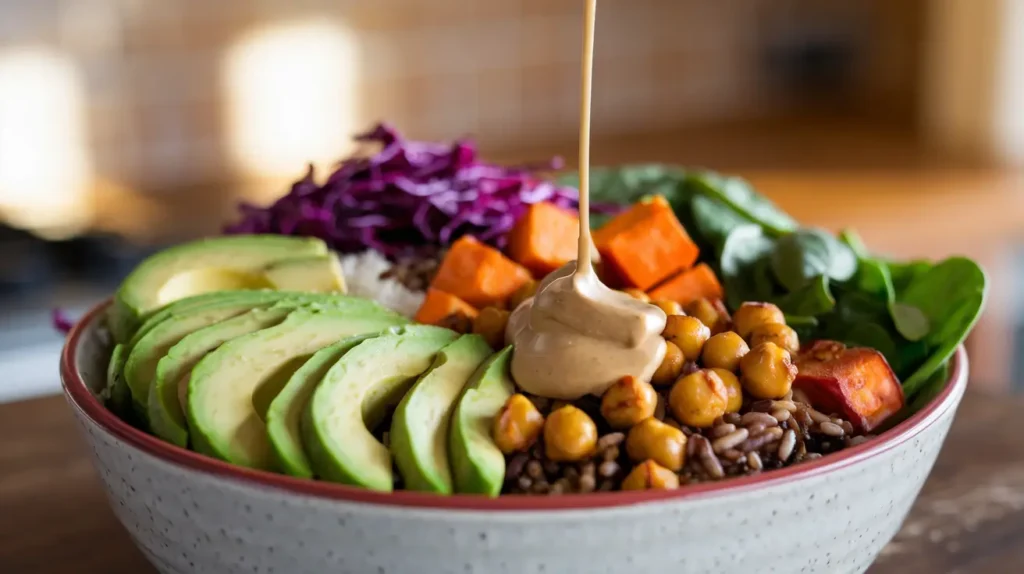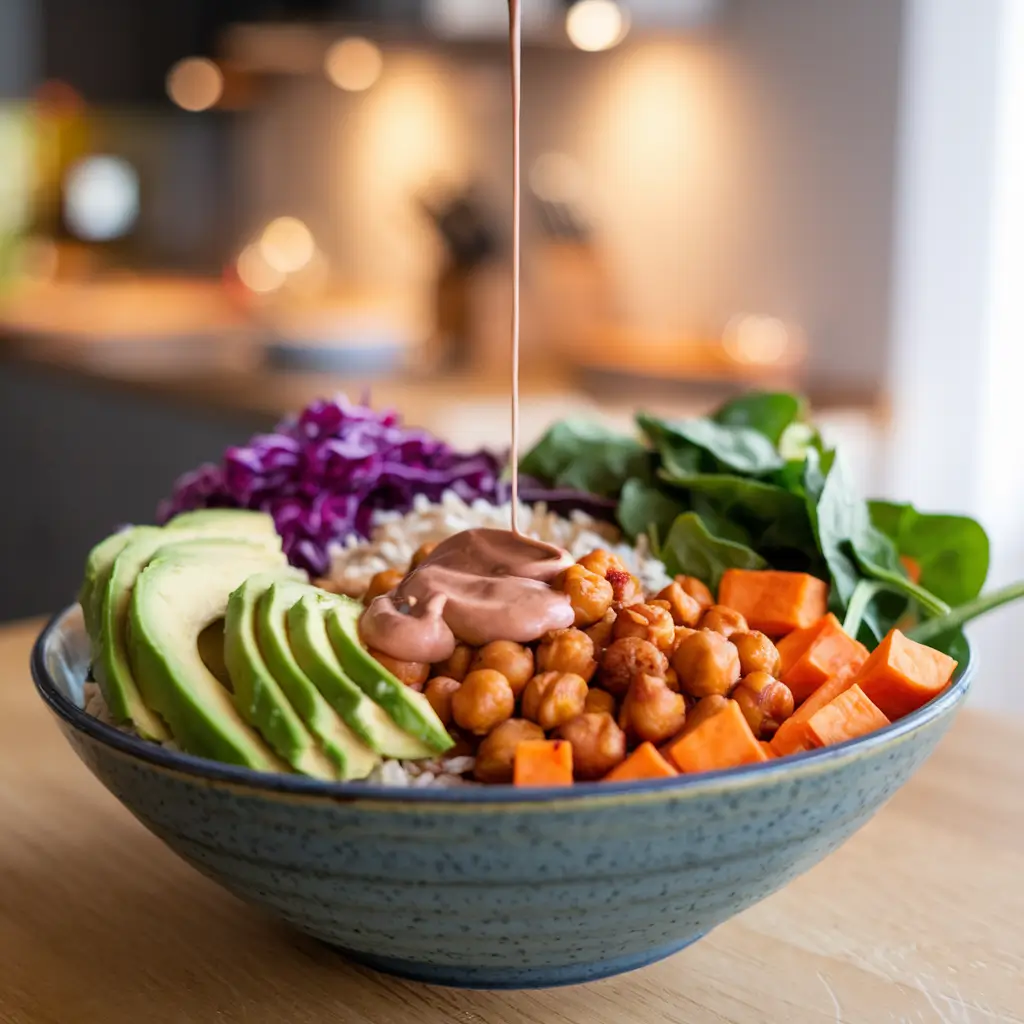
What is a Buddha Bowl Recipe?
A Buddha Bowl Recipe is your ultimate guide to a nutrient-rich, customizable meal that combines flavor, texture, and nutrition in every bite. Perfect for any diet, a Buddha Bowl Recipe typically includes a base of grains or greens, a protein source, a mix of colorful vegetables, and a flavorful dressing. If you’re searching for a quick, healthy meal option, this Buddha Bowl Recipe is your solution for a balanced and delicious dish.
Why Are Buddha Bowls So Popular?
The popularity of Buddha Bowls continues to rise, and it’s easy to see why. First of all, they are incredibly versatile, meaning they can be adapted to suit any dietary needs, whether vegan, gluten-free, or high-protein. Furthermore, they encourage the use of seasonal produce, which not only adds variety but also enhances their nutritional value.
Additionally, Buddha Bowls are perfect for those who enjoy meal prepping. By preparing ingredients ahead of time, you can quickly assemble a balanced and flavorful meal. Similarly, dishes like this sheet pan shrimp and veggies recipe emphasize simplicity without compromising on nutrition.
The Anatomy of a Perfect Buddha Bowl
To create the perfect Buddha Bowl, it’s essential to include five key components. Each of these elements plays a vital role in making the bowl both delicious and nutritious.
1. The Base
Begin with a foundation that provides substance and texture. For example:
- Grains: Quinoa, brown rice, or farro.
- Greens: Spinach, kale, or arugula.
2. Protein
Next, choose a protein to make the dish more filling. Consider the following:
- Plant-based: Tofu, tempeh, or chickpeas.
- Animal-based: Grilled chicken, salmon, or boiled eggs.
3. Vegetables
Vegetables add both color and flavor to your bowl. For instance:
- Roasted: Sweet potatoes, zucchini, or carrots.
- Fresh: Cucumber, cherry tomatoes, or shredded cabbage.
4. Toppings
To enhance the overall texture and taste, add toppings such as:
- Seeds: Sunflower, sesame, or chia seeds.
- Crunchy elements: Nuts or crispy chickpeas.
5. Dressing
Finally, bring everything together with a flavorful dressing. Options include:
- Creamy: Tahini, peanut sauce, or avocado dressing.
- Tangy: Lemon vinaigrette or balsamic glaze.
How to Make the Perfect Buddha Bowl Recipe
Although Buddha Bowls may appear complex, they are surprisingly simple to assemble. Follow these steps to craft your own:
Step 1: Choose Your Base
Start with a grain or leafy green that serves as the foundation of your bowl.
Step 2: Add Protein
Include a protein source, such as marinated tofu or grilled chicken, to make the bowl satisfying.
Step 3: Layer Vegetables
Incorporate a mix of roasted and fresh vegetables to achieve a variety of flavors and textures.
Step 4: Sprinkle Toppings
Add crunch and flavor with nuts, seeds, or crispy chickpeas.
Step 5: Drizzle Dressing
Finish your bowl by drizzling it with a dressing that complements the other ingredients.
By following these steps, you can create a meal that is not only delicious but also balanced and visually appealing.
Essential Components of Every Buddha Bowl Recipe
If you’re unsure where to start, these tried-and-true recipes can serve as excellent inspiration:
Sweet Potato Chickpea Buddha Bowl
- Base: Quinoa.
- Protein: Chickpeas.
- Veggies: Sweet potatoes, kale.
- Dressing: Lemon tahini sauce.
Thai-Inspired Chicken Bowl
- Base: Brown rice.
- Protein: Grilled chicken.
- Veggies: Cabbage, cucumber, shredded carrots.
- Dressing: Spicy peanut sauce.
Vegan Rainbow Bowl
- Base: Spinach.
- Protein: Tofu.
- Veggies: Purple cabbage, avocado, bell peppers.
- Dressing: Ginger miso sauce.
Benefits of Including a Buddha Bowl Recipe in Your Diet

Not only are Buddha Bowls delicious, but they also provide several health benefits:
- Balanced Nutrition: Each bowl contains a mix of fiber, protein, and healthy fats, ensuring a complete and satisfying meal.
- Customizable Options: Whether you’re following a gluten-free, vegan, or high-protein diet, these bowls can be easily adjusted to meet your needs.
- Meal Prep-Friendly: Preparing ingredients in advance allows you to save time while still enjoying fresh and nutritious meals.
For those who enjoy meal prep, you might also like this ground beef and sweet potato recipe, which offers another quick and healthy option.
Common Mistakes to Avoid
Even though Buddha Bowls are simple to make, there are a few common mistakes to watch out for:
1. Overloading Ingredients
While variety is important, adding too many elements can overwhelm the flavors and make the bowl less enjoyable.
2. Skipping the Dressing
The dressing is essential because it ties all the components together, so don’t forget this crucial step.
3. Not Balancing Textures
To keep every bite interesting, ensure your bowl includes a mix of soft, crunchy, and creamy textures.
FAQs About Buddha Bowls
What is the best base for a Buddha Bowl?
Quinoa or mixed greens are excellent choices because they offer fiber and nutritional value.
Can Buddha Bowls be made gluten-free?
Yes! Simply use gluten-free grains like quinoa, and double-check that your dressings and toppings are gluten-free.
Are Buddha Bowls healthy?
Absolutely! With their balanced combination of vegetables, proteins, and healthy fats, they’re a powerhouse meal option.
Conclusion
In conclusion, Buddha Bowls are a versatile and nutritious dish that can be tailored to fit any dietary preference. By following the tips and recipes provided, you can create a meal that is not only delicious but also visually appealing and balanced. Whether you’re preparing meals for the week or looking for a quick and satisfying dinner, Buddha Bowls are the perfect solution.
For additional meal ideas, check out this gluten-free breakfast casserole guide, which provides another way to enjoy simple and nutritious eating.
